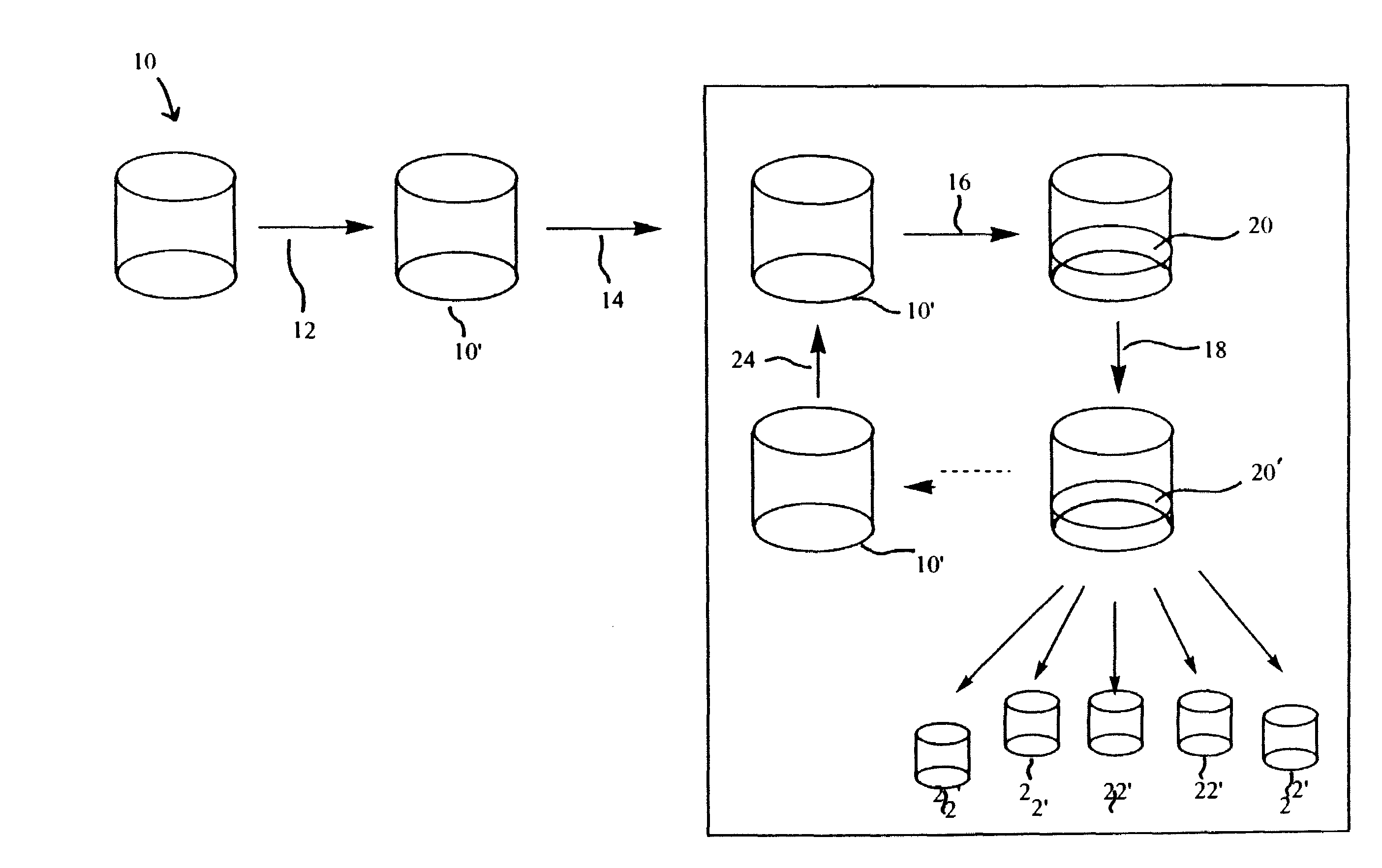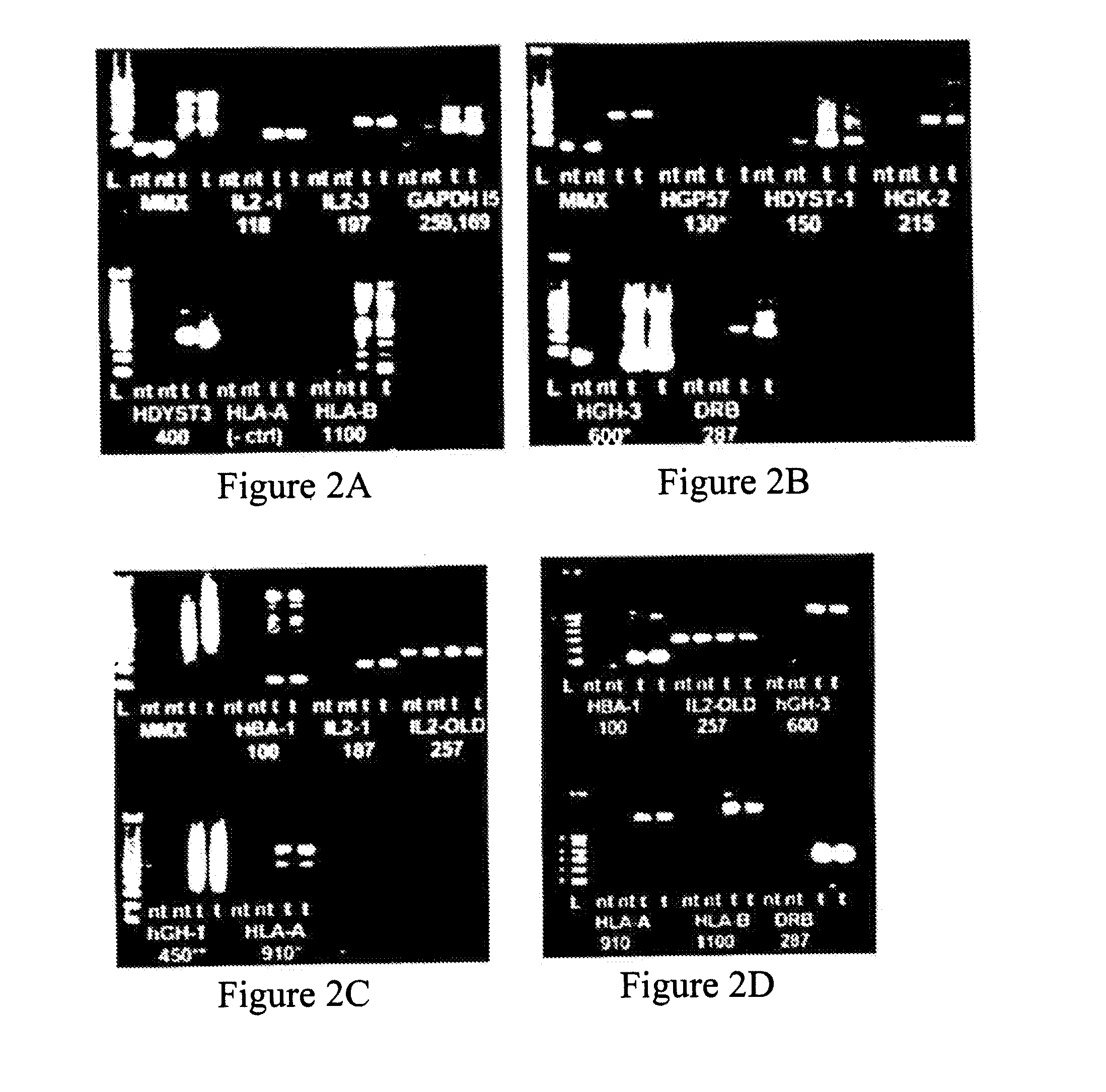Methods for multiplexing amplification reactions
a technology of amplification reaction and multiplexing, which is applied in the direction of biochemistry apparatus and processes, instruments, material analysis, etc., can solve the problems of limited quantity of targeted nucleic acids, cumbersome and time-consuming multiple assays by this procedure, and limited detection and screening of specific nucleic acids using nucleic acid amplification techniques, so as to reduce primer artifacts and boost target copy number
- Summary
- Abstract
- Description
- Claims
- Application Information
AI Technical Summary
Benefits of technology
Problems solved by technology
Method used
Image
Examples
example 1
Multiplex Amplification Incorporating Booster PCR and Archiving
1. Primer Design:
[0049]The Xtra Amp™ Extraction Kit (Xtrana, Inc.) provides an innovative system for nucleic acid extraction in which the nucleic acid remains bound in the extraction tube and can be directly amplified by PCR in this same tube. The unique principle underlying this system lies in the proprietary nucleic acid binding matrix, Xtra Bind™. Xtra Bind™ is a non-silica matrix which stably and irreversibly binds both DNA and RNA. The Xtra Amp™ kit contains 96 (as 1×8 strips) 0.2 mL size microcentrifuge tubes coated with the Xtra Bind™ matrix, cell lysis buffer and wash buffer. The kit is commercially available currently for extraction of genomic DNA from, whole blood (manufactured and distributed for Xtrana, Inc. by ANSYS Diagnostics, Lake Forest, Calif.). For demonstrating Xtra Plex feasibility, the Xtra Amp™ Blood kit was chosen as the extraction platform. For the PCR multiplexing experiments it was decided to o...
example 2
Sequential Booster Xtra Plex NASBA Reaction of Solid-Phase Captured Nucleic Acid
1. Booster Xtra Plex NASBA First Pass
[0062]Several NASBA systems are currently in operation in our lab. From these, ten primer sets as shown in Table 2 were chosen. These were: (1) for Escherichia coli: SZ gene (SZ), SLT1 and 2 genes (SLT1, SLT2), 16S ribosomal RNA (16S), LacZ (LacZ 1 and LacZ 2), and UIDA gene (UIDA); (2) for Listeria monocytogenes: HlyA gene; (3) for Nisseria gonorrhea: 16s ribosomal RNA (NG2); and (4) for Chlamydia trachomatis: 16s ribosomal RNA (CT2). Surprisingly, the primers LACZ 1 and LACZ 2 have been shown to be specific to E. coli and can discriminate E. coli from other coliform species. The 16s ribosomal (16s) primer set is capable of binding to and allowing amplification of all gram-negative bacteria examined and may be a universal primer set for all gram-negative bacteria.
TABLE 2SEQ IDORGANISMNO:GENEaSEQUENCEC. trachomatis47CT2: FPAATTCTAATACGACTCACTATAGGGAGAGGTAACCGAAAGGTCCT...
example 3
Detection of E. Coli Using Sequences that Uniquely Identify E. Coli
[0068]The E. coli gene lacZ coding for beta-galactosidase (EC 3.2.1.23) was for identifying sequences that uniquely identify E. coli. Various sequences of use in the detection of E. coli were located between base pairs 1700 to 1950 of the LacZ gene, identified as SEQ ID NO: 100 and shown below. Table 4 shows the lac Z gene sequences described by base pair number position relative to the E. coli genomic sequence in Genbank (accession VOO296, version VOO296.1 GI:41901).
SEQ ID NO: 100TCTGGGACTGGGTGGATCAGTCGCTGATTAAATATGATGAAAACGGCAACCCGTGGTCGGCTTACGGCGGTGATTTTGGCGATACGCCGAACGATCGCCAGTTCTGTATGAACGGTCTGGTCTTTGCCGACCGCACGCCGCATCCAGCGCTGACGGAAGCAAAACACCAGCAGCAGTTTTTCCAGTTCCGTTTATCCGGGCAAACCATCGAAGTGACCAGCGAATACCTGTTCCGTCATAGCGATAACGAG
[0069]For specificity studies, nucleic acid was extracted onto Xtra Amp™ tubes (Xtrana, Inc, series III extraction kits) starting with high copy number (1,000,000 CFU) of various bacteria foll...
PUM
| Property | Measurement | Unit |
|---|---|---|
| pH | aaaaa | aaaaa |
| pH | aaaaa | aaaaa |
| melting temperatures | aaaaa | aaaaa |
Abstract
Description
Claims
Application Information
 Login to View More
Login to View More - R&D
- Intellectual Property
- Life Sciences
- Materials
- Tech Scout
- Unparalleled Data Quality
- Higher Quality Content
- 60% Fewer Hallucinations
Browse by: Latest US Patents, China's latest patents, Technical Efficacy Thesaurus, Application Domain, Technology Topic, Popular Technical Reports.
© 2025 PatSnap. All rights reserved.Legal|Privacy policy|Modern Slavery Act Transparency Statement|Sitemap|About US| Contact US: help@patsnap.com



